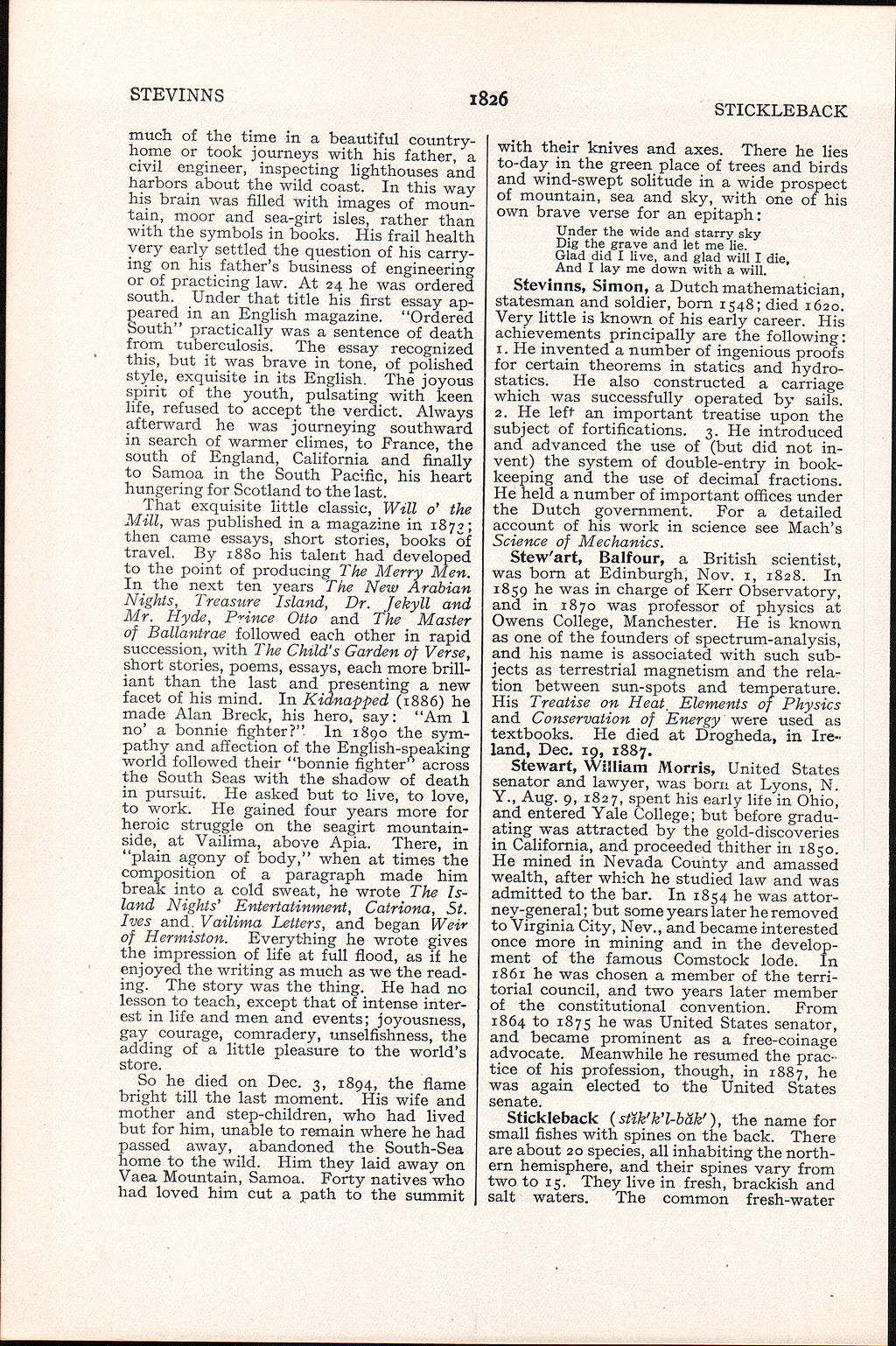STEVINNS
1826
STICKLEBACK
much of the time in a beautiful country-home or took journeys with his father, a civil engineer, inspecting lighthouses and harbors about the wild coast. In this way his brain was filled with images of mountain, moor and sea-girt isles, rather than with the symbols in books. His frail health very early settled the question of his carrying on his father's business of engineering or of practicing law. At 24 he was ordered south. Under that title his first essay appeared in an English magazine. "Ordered South" practically was a sentence of death from tuberculosis. The essay recognized this, but it was brave in tone, of polished style, exquisite in its English, The joyous spirit of the youth, pulsating with keen life, refused to accept the verdict. Always afterward he was journeying southward in search of warmer climes, to France, the south of England, California and finally to Samoa in the South Pacific, his heart hungering for Scotland to the last.
That exquisite little classic, Will o* the Mill, was published in a magazine in 1873; then came essays, short stories, books of travel. By 1880 his talent had developed to the point of producing The Merry Men. In the next ten years The New Arabian Nights, Treasure Island, Dr. Jekyll and Mr. Hyde, Prince Otto and The Master of Ballantrae followed each other in rapid succession, with The Child's Garden of Verse, short stories, poems, essays, each more brilliant than the last and presenting a new facet of his mind. In Kidnapped (1886) he made Alan Breck, his hero, say: "Am 1 no' a bonnie fighter?" In 1890 the sympathy and affection of the English-speaking world followed their "bonnie fighter" across the South Seas with the shadow of death in pursuit. He asked but to live, to love, to work. He gained four years more for heroic struggle on the seagirt mountainside, at Vailima, above Apia. There, in "plain agony of body," when at times the composition of a paragraph made him break into a cold sweat, he wrote The Island Nights' Entertatinment, Catriona, St. Ives and, Vailima Letters, and began Weir of Hermiston. Everything he wrote gives the impression of life at full flood, as if he enjoyed the writing as much as we the reading. The story was the thing. He had no lesson to teach, except that of intense interest in life and men and events; joyousness, gay courage, comradery, unselfishness, the adding of a little pleasure to the world's store.
So he died on Dec. 3, 1894, the flame bright till the last moment. His wife and mother and step-children, who had lived but for him, unable to remain where he had passed away, abandoned the South-Sea home to the wild. Him they laid away on Vaea Mountain, Samoa. Forty natives who had loved him cut a path to the summit
with their knives and axes. There he lies to-day in the green place of trees and birds and wind-swept solitude in a wide prospect of mountain, sea and sky, with one of his own brave verse for an epitaph:
Under the wide and starry sky Dig the grave and let me lie. Glad did I live, and glad will I die, And I lay me down with a will.
Stevinns, Simon, a Dutch mathematician, statesman and soldier, born 1548; died 1620. Very little is known of his early career. His achievements principally are the following:
1. He invented a number of ingenious proofs for certain theorems in statics and hydrostatics. He also constructed a carriage which was successfully operated by sails.
2. He left an important treatise upon the subject of fortifications. 3. He introduced and advanced the use of (but did not invent) the system of double-entry in bookkeeping and the use of decimal fractions. He held a number of important offices under the Dutch government. For a detailed account of his work in science see Mach's Science of Mechanics.
Stew'art, Balfour, a British scientist, was born at Edinburgh, Nov. i, 1828. In 1859 he was in charge of Kerr Observatory, and in 1870 was professor of physics at Owens College, Manchester. He is known as one of the founders of spectrum-analysis, and his name is associated with such subjects as terrestrial magnetism and the relation between sun-spots and temperature. His Treatise on Heat. Elements of Physics and Conservation of Energy were used as textbooks. He died at Drogheda, in Ireland, Dec. io, 1887.
Stewart, William Morris, United States senator and lawyer, was born at Ly^ons, N. Y., Aug. 9, 1827, spent his early life in Ohio, and entered Yale College; but before graduating was attracted by the gold-discoveries in California, and proceeded thither in 1850. He mined in Nevada County and amassed wealth, after which he studied law and was admitted to the bar. In 1854 he was attorney-general ; but some years later he removed to Virginia City, Ney., and became interested once more in mining and in the development of the famous Comstock lode. In 1861 he was chosen a member of the territorial council, and two years later member of the constitutional convention. From 1864 to 1875 he was United States senator, and became prominent as a free-coinage advocate. Meanwhile he resumed the practice of his profession, though, in 1887, he was again elected to the United States senate.
Stickleback (stW&l-bak'}, the name for small fishes with spines on the back. There are about 20 species, all inhabiting the northern hemisphere, and their spines vary from two to 15. They live in fresh, brackish and salt waters. The common fresh-water
